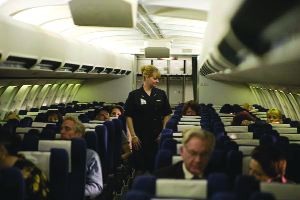Revisiting 9/11

It’s natural to hesitate before committing yourself to sitting through a movie about a September 11 hijacking. You feel your stomach tighten in an unusual way during the first few scenes of United 93, as the crew boards the plane, casually exchanging details about their personal lives, and the passengers converge at the gate in the familiar restless positions of travelers impatient to get on their way.
There’s a history of movies about famous disasters, some of which, like the 1958 British film about the Titanic, A Night to Remember, have been made with sensitivity and restraint. What’s different about this film is that every American who lays down ten bucks to see it lived through 9/11, and the tale of the passengers who successfully wrested the plane away from al-Qaeda hijackers but died in the process hasn’t had a chance to solidify into myth. So, whether for good or bad, seeing United 93 is destined to be a raw experience.
The movie is not just good enough to justify being made; it’s superb. The director is the Britisher Paul Greengrass, who made the extraordinary docudrama Bloody Sunday, which dramatizes the 1972 Irish civil rights march that turned into a massacre. No one could have been a better choice for this material. Greengrass is a master of documentary realism—of what used to be called cinéma vérité—but he operates without the self-consciousness that usually accompanies that style. When he uses a hand-held camera to move in close and simulate the effect of violence or chaos in an enclosed space, he’s so precise that the focus is always on the way that the men and women on the plane experience the event; the device itself doesn’t get between them and us.
Greengrass wrote the script, but it feels entirely improvised, and some of it surely was, since many of the people we see on the screen are playing themselves—including Ben Sliney, who on 9/11 was starting his first day as national supervisor at FAA headquarters in Herndon, Virginia. (It seems odd to compliment a nonactor who’s re-creating a few critical hours in his own life, but Sliney is terrific.)
Greengrass avoided casting familiar faces. I recognized among those portraying the passengers and crew only two talented character actors, Christian Clemenson as Thomas Burnett (one of the prime movers in the disarming of the terrorists) and John Rothman as Edward Felt (who made a call on his cell from one of the plane’s lavatories). You’ve never seen a more naturalistic—that is, less actorish— ensemble.
Though the story has its heroes—besides Burnett there is Todd Beamer (David Alan Basche), William Cashman (Richard Bekins) and Mark Bingham (Cheyenne Jackson)—Greengrass never hypes them up. Nor does he demonize the hijackers. Greengrass doesn’t have a single melodramatic impulse. Even the scenes of overlapping phone calls from passengers saying goodbye to their loved ones never fall into sentimentality.
Greengrass knows how to orchestrate a mood and shape a dramatic sequence. As the male passengers plot their insurrection, the terrorists seem paralyzed by their own hysteria, and time seems weirdly suspended. Greengrass intercuts this scenario with the scene at Herndon, where bafflement escalates into horror and increasingly desperate efforts to monitor the United planes that keep disappearing from the radar, and with the frantic scrambling of the military to deal with the emergency. He always emphasizes the authentic details of ordinary people’s responses. Somehow he manages to do so without theatricalizing those details, so we have the illusion that they’re not being filtered through a director’s point of view (though of course they are).
The movie is able to render tremendous intensity of feeling with delicacy. Greengrass never pushes for an effect. He’s at the furthest remove from being exploitative. He trusts the material to make its point without editorial interference.
The final setpiece imagines the last minutes before the crash in Pennsylvania. There is no aftermath, no discussion of the meaning of the event, no eulogies. (A few postscripts appear on the screen before the credits roll; that’s all.) Greengrass observes the humanity of those aboard United 93, and the film serves as a fitting memorial.




